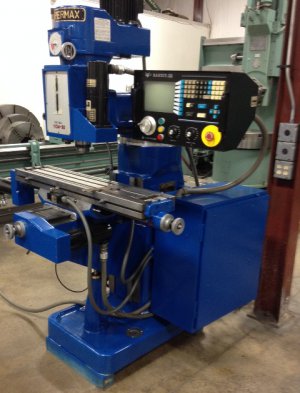- Joined
- May 7, 2014
- Messages
- 776
DC Servo motors for CNC - Source? why so pricey...
Ok, Newb w/ a new 80's servo system on a Bandit III CNC controller. Learning about the Servo world. I come from a Mach 3/ hobby stepper setup. Now I am trying to see if I'll want to upgrade to a ajax centroid setup. I like what I see there. I am finding out that a DC Servo, 40inlb+ w/ encoder diff/quad from the CNC retro site is $1,300 a piece from that Vendor. I simply cannot afford that. The controller and driver, no motors, w/ Centroid is about $2K for the kit.
Q1- Any vendors for a DC servo 40+ inch pounds welcome.
I'm told that my mill has DC 90v motors w/ the diff/quad encoders ( hope I have that right). I did not get a pic of the badge on those... Check out the size of the motor off the X & Y mounts on the table.
As usual- Just trying to learn in advance of the units arrival next week. a Bandit III manual, Comms and cable set will be about $400 That is almost 1/5th the ajax retro kit. See why I'm struggling?
OEM kit:
I can supply my own DC server motors and even put on their encoders (for $225 apiece) if I cannot get the diff/quad and DC servo aio (all in one) .
Hope to reuse the Motors already on there. If so, No clue on the encoder counts if that even matters. The OEM is 2500 or 2000 on their add-on encoders and I could put the onto these motors as well.
I think I'm realizing that while the Bandit III would be a fun 'old school' project - I simply do not have the time and $$ to toss-out on this.
Q2: And I see far more AC servo motors than DC? Not sure what's up there.. For CNC is the rule usually DC based Servo setups for safety & digital readiness reasons?
WWYD (what would you do) Input welcome as always gang. If you know of some OTS (off the shelf) vendors for Servo motor and driver setups . Send a shout pls.


Ok, Newb w/ a new 80's servo system on a Bandit III CNC controller. Learning about the Servo world. I come from a Mach 3/ hobby stepper setup. Now I am trying to see if I'll want to upgrade to a ajax centroid setup. I like what I see there. I am finding out that a DC Servo, 40inlb+ w/ encoder diff/quad from the CNC retro site is $1,300 a piece from that Vendor. I simply cannot afford that. The controller and driver, no motors, w/ Centroid is about $2K for the kit.
Q1- Any vendors for a DC servo 40+ inch pounds welcome.
I'm told that my mill has DC 90v motors w/ the diff/quad encoders ( hope I have that right). I did not get a pic of the badge on those... Check out the size of the motor off the X & Y mounts on the table.
As usual- Just trying to learn in advance of the units arrival next week. a Bandit III manual, Comms and cable set will be about $400 That is almost 1/5th the ajax retro kit. See why I'm struggling?
OEM kit:
I can supply my own DC server motors and even put on their encoders (for $225 apiece) if I cannot get the diff/quad and DC servo aio (all in one) .
Hope to reuse the Motors already on there. If so, No clue on the encoder counts if that even matters. The OEM is 2500 or 2000 on their add-on encoders and I could put the onto these motors as well.
I think I'm realizing that while the Bandit III would be a fun 'old school' project - I simply do not have the time and $$ to toss-out on this.
Q2: And I see far more AC servo motors than DC? Not sure what's up there.. For CNC is the rule usually DC based Servo setups for safety & digital readiness reasons?
WWYD (what would you do) Input welcome as always gang. If you know of some OTS (off the shelf) vendors for Servo motor and driver setups . Send a shout pls.


Last edited:
